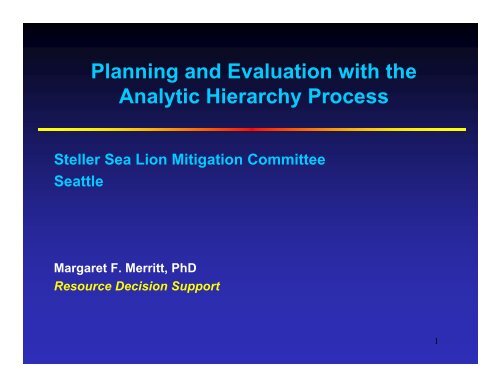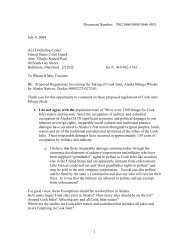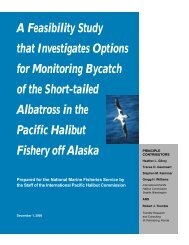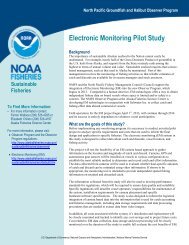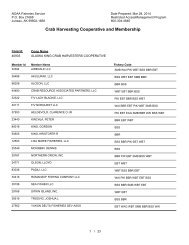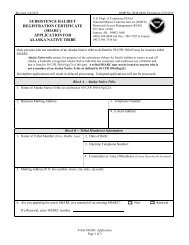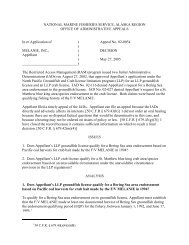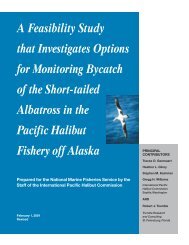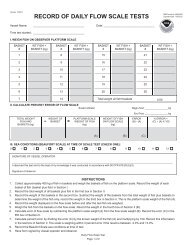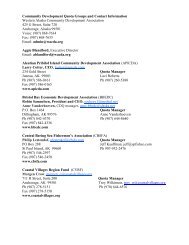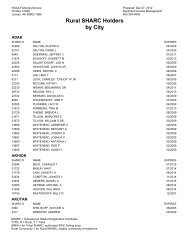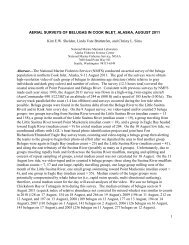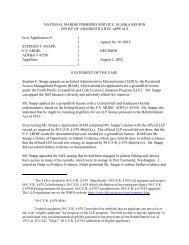Planning and Evaluation with the Analytic Hierarchy Process
Planning and Evaluation with the Analytic Hierarchy Process
Planning and Evaluation with the Analytic Hierarchy Process
Create successful ePaper yourself
Turn your PDF publications into a flip-book with our unique Google optimized e-Paper software.
<strong>Planning</strong> <strong>and</strong> <strong>Evaluation</strong> <strong>with</strong> <strong>the</strong><br />
<strong>Analytic</strong> <strong>Hierarchy</strong> <strong>Process</strong><br />
Steller Sea Lion Mitigation Committee<br />
Seattle<br />
Margaret F. Merritt, PhD<br />
Resource Decision Support<br />
1
This presentation includes<br />
• Introduction to strategic planning<br />
– How <strong>the</strong> planning process works<br />
– Philosophies of planning<br />
• Dealing <strong>with</strong> complexity: Systems Analysis<br />
<strong>and</strong> <strong>the</strong> The <strong>Analytic</strong> <strong>Hierarchy</strong> <strong>Process</strong><br />
– Applications<br />
– Structuring <strong>and</strong> <strong>the</strong> rating scale<br />
– Criteria<br />
– Making <strong>and</strong> combining judgments<br />
– Syn<strong>the</strong>sis <strong>and</strong> examples<br />
• Strawdog<br />
2
Introduction to Strategic <strong>Planning</strong><br />
• Strategic: Long term future based on goals<br />
– Most fisheries plans have a 3-5 year time horizon<br />
• <strong>Planning</strong>: A repetitive decision making activity<br />
involving thinking & social processes that help to<br />
design what is perceived as a desirable outcome<br />
based on future goals.<br />
“Are we doing <strong>the</strong> right thing?”<br />
3
How <strong>the</strong> <strong>Planning</strong> <strong>Process</strong> Works<br />
• Recognize <strong>the</strong>re is a problem<br />
• Who should participate <strong>and</strong> how?<br />
- Who will clarify <strong>the</strong> situation <strong>and</strong> define criteria?<br />
- Who will offer judgments (vote)?<br />
- Will participation be through review, panel, or at <strong>the</strong> table?<br />
• Identify <strong>the</strong> scope<br />
- Geographic area<br />
- Cast of characters<br />
- Time frame(s); e.g., short term, long term<br />
• Identify expected products <strong>and</strong> time line<br />
4
How <strong>the</strong> <strong>Planning</strong> <strong>Process</strong> Works<br />
• Select a planning approach<br />
– Top/down: You know <strong>the</strong> ruling, but are not sure which<br />
proposals will help to stay above <strong>the</strong> “jeopardy bar”<br />
• Select a decision technique. The benefits of using a<br />
formal decision technique include:<br />
- clearly defined objectives<br />
- <strong>the</strong> ability to incorporate various information sources<br />
- consideration of multiple perspectives<br />
- an increased likelihood of finding an optimal solution.<br />
• Prepare for <strong>the</strong> meeting<br />
5
Philosophies of <strong>Planning</strong><br />
• Incremental (see Lindblom) Identifies a course of action that<br />
is just good enough to produce reasonable improvement<br />
- political bargaining<br />
- building coalitions<br />
• Operations Research (see Hillier & Lieberman)<br />
Quantitative models & optimization methods seek a solution<br />
which is in an objective state<br />
- forecasting models<br />
- decision analysis (MAUT, decision trees)<br />
• Systems Analysis (see Saaty) The whole of a complex<br />
system <strong>and</strong> <strong>the</strong> relationships of its parts is analyzed<br />
- <strong>Analytic</strong> <strong>Hierarchy</strong> <strong>Process</strong> (AHP)<br />
6
Dealing <strong>with</strong> Complexity<br />
• A complex problem is characterized by:<br />
- Diffused authority, multiple jurisdictions across a vast area<br />
- Research or management involves many disciplines<br />
- Incomplete knowledge <strong>and</strong> uncertainty<br />
• 1950’s: Systems research developed for solving<br />
complex problems<br />
• 1970’s: AHP applied in <strong>the</strong> fields of military science,<br />
medicine, engineering, policy, business<br />
• 1990’s: AHP applied in <strong>the</strong> fields of fisheries, natural<br />
resource allocation <strong>and</strong> restoration<br />
7
Fisheries Applications of <strong>the</strong> AHP<br />
Strategic planning for salmon (<strong>and</strong> non-salmon) research<br />
<strong>and</strong> management<br />
Merritt & Criddle 1993<br />
Merritt 1999, 2004<br />
Merritt & Skilbred 2001<br />
USFWS 2005, 2006<br />
Bristol Bay/Chignik<br />
2005<br />
Kuskokwim<br />
2004<br />
Kodiak/Aleutians<br />
2005-06<br />
Copper River/PWS<br />
1999, 2005<br />
Kenai River<br />
1993, 2005-06<br />
Sou<strong>the</strong>ast<br />
2001, 2006<br />
8
More Applications of <strong>the</strong> AHP<br />
• PingSun Leung, Univ. Hawaii 1998-2006<br />
– Evaluating fisheries management options<br />
• Mark Ridgley, Univ. Hawaii 1994-2006<br />
– <strong>Evaluation</strong> of restoration policies for a Rhine estuary<br />
• Gerard DiNardo, Univ. of Maryl<strong>and</strong> 1989<br />
– Manage Maryl<strong>and</strong>’s river herring fishery<br />
• NEFC, NMFS 1990<br />
– Guidance on <strong>the</strong> FY91 research program (cutbacks)<br />
• Dave Mackett, SWFC, NMFS 1985<br />
– Systems Analysis: Strategic planning for research <strong>and</strong><br />
management of <strong>the</strong> albacore tuna fishery<br />
9
<strong>Analytic</strong> <strong>Hierarchy</strong> <strong>Process</strong><br />
• What is AHP?<br />
– A systems approach for thinking: examine parts of <strong>the</strong> whole<br />
system <strong>and</strong> <strong>the</strong>ir linkages<br />
– A tool for integrating expert judgments<br />
• Why AHP?<br />
– Clearly & concisely communicates <strong>the</strong> problem<br />
– Considers different points of view<br />
– Encourages explicit statements of preference, importance<br />
– Increases <strong>the</strong> likelihood of finding an optimal solution<br />
• How does it work?<br />
– Structures <strong>the</strong> problem into a hierarchy<br />
– Prioritizes elements based on judgments<br />
10
Sources of<br />
mortality<br />
Project<br />
A<br />
System<br />
productivity<br />
Complex Problem<br />
Harvest <strong>with</strong> caution<br />
Rebuild<br />
stocks<br />
Project<br />
B<br />
Accurate<br />
escapement<br />
Effective<br />
enforcement<br />
Project<br />
C<br />
Effective<br />
management<br />
11
Need to estimate<br />
or index<br />
total run<br />
Goal: Improve information to<br />
sustain salmon populations<br />
Define<br />
abundance<br />
<strong>and</strong> timing<br />
What are<br />
migratory<br />
patterns?<br />
Underst<strong>and</strong><br />
dynamics<br />
What are impacts<br />
of fishing?<br />
Evaluate<br />
escapement<br />
Need to<br />
document<br />
historic levels<br />
12
9 Extremely important<br />
7 Very strong<br />
5 Strong<br />
3 Moderate<br />
1 Slight<br />
Rating Scales<br />
13
Criteria for Weighting<br />
Use criteria to help judge importance (or<br />
preference) among elements in a group:<br />
– Degree of allocation conflict & intensity of management<br />
– Degree of conservation concerns; or, vulnerability of<br />
stocks to overexploitation<br />
– Is <strong>the</strong>re a sequential nature, where inquiry into one area is<br />
pending <strong>the</strong> results from some o<strong>the</strong>r area?<br />
14
Use Expert Judgment to Compare<br />
Size<br />
Comparison<br />
Apple A Apple B Apple C<br />
Resulting<br />
Priority<br />
Eigenvector<br />
Relative Size<br />
of Apple<br />
Apple A 1 2 6 6/10 0.6<br />
Apple B 1/2 1 3 3/10 0.3<br />
Apple C 1/6 1/3 1 1/10 0.1<br />
Sum column numbers.<br />
Divide each number by column total to obtain a normalized matrix.<br />
Obtain <strong>the</strong> average across each row.<br />
This gives normalized relative priorities = approximate eigenvector.<br />
15
Combining Judgments<br />
• Dissent & debate<br />
– Explores alternative viewpoints<br />
– Debate can bring judgments closer through learning<br />
– Leads to underst<strong>and</strong>ing & cooperation<br />
– A well-informed person can effect change in belief !<br />
• When consensus is lacking:<br />
– The geometric mean is <strong>the</strong> appropriate method for<br />
combining judgments made on a ratio scale<br />
– We record <strong>the</strong> spread<br />
16
Syn<strong>the</strong>size to Get Priorities<br />
Foster fishery<br />
research to advance<br />
information for<br />
management of<br />
sustainable fisheries<br />
Conserve &<br />
rehabilitate fisheries<br />
habitat to maintain &<br />
improve <strong>the</strong> Kenai R<br />
watershed<br />
0 1 2 3 4 5 6 7 8 9<br />
Mean Score<br />
17
Fishery Problems<br />
Fishery Factors: Data on stock composition &<br />
exploitation rates in fisheries are unclear or<br />
suspect<br />
Management Units: Failure to identify sub-stocks<br />
in mixed fisheries risks overexploitation of those<br />
that are less abundant<br />
Stock Assessment: Inaccurate estimates of<br />
escapement contribute to management errors<br />
Productivity: Relationships between<br />
escapement, enhancement & environmental<br />
factors as related to production are unclear<br />
Management Paradigms: Current focus of<br />
management may be inadequate to ensure<br />
sustainability over long time periods<br />
0 1 2 3 4 5 6 7 8 9<br />
Mean Score<br />
18
GOAL PROBLEM OBJECTIVE INFORMATION/ACTION NEED<br />
0.025 a.Need commercial fishery time & area catch<br />
0.045 1.Determine accuracy/precision of stock composition samples for sockeye genetics (ADFG study)<br />
estimates in sport & commercial harvests 0.020 b.Need to improve coho sport & commercial<br />
catch statistics<br />
0.133 A. “Fishery Factors”<br />
Data on stock .030 a.To estimate exploitation first need good basic<br />
composition & 0.045 2.Evaluate <strong>the</strong> occurrence, variability & risks of harvest & escapement data<br />
exploitation rates are & selectivity <strong>and</strong> exploitation rates in sport .015 b.Need to examine size selectivity effects on<br />
unclear or suspect. & commercial fisheries Chinook escapement & diversity<br />
0.020 a.Need funds to augment enforcement in <strong>the</strong><br />
commercial fishery.<br />
0.043 3.Explore methods for minimizing incidental Chinook 0.018 b.The existing commercial harvest data base can<br />
catch & maximizing target sockeye catch in be analyzed more extensively to examine<br />
0.568 1.Foster fishery research commercial fisheries. Chinook time & area stock composition<br />
to advance information 0.005 c.What is feasibility of gear modifications to<br />
for management of minimize Chinook bycatch ?<br />
sustainable salmon<br />
fisheries. 0.021 a.Need to know if “early” & “late” designations<br />
of <strong>the</strong> Chinook return are genetically distinct<br />
0.051 1.Determine if Chinook (early/late runs), sockeye by sampling trib & mainstem spawn areas<br />
(late run), coho (early/late runs) are comprised of 0.019 b.Need to have a DNA baseline (spawning area)<br />
genetic substocks returning to different areas. for all sockeye stocks (ADFG study)<br />
0.011 c.Pending GSI outcomes from Chinook,<br />
sockeye, coho, syn<strong>the</strong>size to examine<br />
identification of spatial/temporal aspects<br />
0.124 B. “Management 0.010 a.Need to conduct Chinook genetic sampling at<br />
Failure to identify sub- river mouth (ADFG study)<br />
stocks in mixed 0.009 b.Need to identify important spawning areas for<br />
risks overexploitation 0.040 2.Determine if genotypic differences are reflected in Chinook using radio telemetry<br />
those that are less phenotypic characteristics (e.g., timing, size) 0.008 c.Need to identify important spawning areas for<br />
sockeye using radio telemetry<br />
0.007 d.Need to conduct sockeye genetic sampling at<br />
river mouth<br />
0.006 e.To underst<strong>and</strong> & estimate coho stock ID,<br />
need fishery genetic samples at fishwheel<br />
0.033 3.Identify habitat conditions (e.g., temperature, 0.017 a.Need baseline annual temperature & flow data<br />
hydrograph) related to differences in substock in tributary streams.<br />
structure & characteristics. 0.016 b.Project effects of shrinking wetl<strong>and</strong>s on coho<br />
19
Need time & area catch samples for sockeye genetics<br />
Information/Action Needs for Fish Goal<br />
Need to improve coho catch statistics<br />
Funds to augment enforcement in <strong>the</strong> commercial fishery<br />
How sensitive is productivity to catch & escapement?<br />
A nalyze commercial harvest data for chinook catch<br />
A re early/late chinook runs genetically distinct?<br />
To estimate exploitation need good catch & escapement data<br />
Need sockeye DNA baseline (spaw ning area)<br />
A nalysis of alternative chinook management approaches<br />
Syn<strong>the</strong>size historical data to examine effects of enhancement<br />
Need to know limiting factors to production<br />
Upgrade chinook sonar w hen better technology is available<br />
Need escapement goals for coho<br />
V erify sockeye sonar counts w ith mark/recap<br />
Pending GSI outcomes, identify spatial/temporal aspects<br />
Conduct chinook genetic sampling at river mouth<br />
Upgrade sockeye sonar w hen better technology is available<br />
Conduct sockeye genetic sampling at river mouth<br />
Need area specific escapement estimates<br />
Identify chinook spaw ning areas using radios<br />
Identify sockeye spaw ning areas using radios<br />
Identify practical management applications of MDN<br />
Continue summarizing sport fish economics<br />
To identify coho stocks, need genetic samples at fishw heel<br />
Examine size selectivity on chinook escapement<br />
A nalysis of alternative coho management approaches<br />
Need baseline temperature & flow data in tributaries<br />
Project effects of shrinking w etl<strong>and</strong>s on coho<br />
Syn<strong>the</strong>size historic data to examine productivity factors<br />
Integrate catch quality in commercial fish management<br />
Fe a s ib ility o f m o d if y in g g e a r to m in im iz e c h in o o k b y c a tc h ?<br />
Examine effects of regulatory changes on populations<br />
0 0.02 0.04 0.06 0.08<br />
Priority<br />
Key<br />
Black: open to<br />
proposals<br />
Blue: funded &<br />
remains open<br />
Orange: funded,<br />
not open<br />
Brown: o<strong>the</strong>r<br />
funds, not open<br />
Striped: not<br />
eligible<br />
20
Stage I: Strawdog<br />
Goal: Evaluate proposals for change in SSL protection measures. To what degree would a proposal affect SSL?<br />
<strong>the</strong> fishery?<br />
Factors influencing degree of benefits (impacts) to <strong>the</strong> SSL. The objective is to identify scenario that will keep<br />
situation "above jeopardy bar".<br />
Fish<br />
Abundance of target species<br />
Diversity of fish assemblage (alternative prey)<br />
Factors Influencing SSL Jeopardy Bar<br />
Response of fish to fishing<br />
Factor G<br />
Proximity to SSL site (3, 10, 20 nm)<br />
Factor F<br />
SSL<br />
Factor E<br />
Type of site<br />
Factor D<br />
Abundance of SSL during fishing season<br />
Predators<br />
Factor C<br />
Abundance at SSL site<br />
Factor B<br />
Fishery<br />
Factor A<br />
Gear type<br />
Proximity of fishing to SSL site<br />
Duration of fishery<br />
Season of fishery<br />
Priority<br />
Factors influencing degree of benefits (profit loss)<br />
scenario <strong>with</strong> positive socioeconomics.<br />
to fishing industry. The objective is to identify<br />
Fish<br />
Abundance of target species<br />
Factors Influencing <strong>the</strong> Fishery<br />
Diversity of fish assemblage (bycatch)<br />
Factor G<br />
Response of fish to fishing<br />
Factor F<br />
SSL<br />
Factor E<br />
Fishery<br />
Factor D<br />
Gear type (social issue)<br />
Proximity of fishing to fish (economic issue)<br />
Duration of fishery<br />
Factor C<br />
Factor B<br />
Season of fishery<br />
Factor A<br />
Catch rate<br />
Public opinion<br />
Priority<br />
21<br />
0 0.04 0.08 0.12 0.16 0.2 0.24<br />
0 0.04 0.08 0.12 0.16 0.2 0.24
Stage II:<br />
Develop Criteria to Evaluate Proposals<br />
Weight<br />
9<br />
9<br />
7<br />
6<br />
5<br />
5<br />
4<br />
Addresses strategic priorities<br />
Resolves or lessens conflict<br />
Collects information to address data gaps<br />
Technical merit, feasibility, likelihood of success<br />
Develops partnerships<br />
Criterion<br />
Public outreach, improves public opinion<br />
Administrative/implementation cost<br />
22
Summary<br />
• Strategic planning using <strong>the</strong> AHP can achieve <strong>the</strong>se<br />
products:<br />
– Identification <strong>and</strong> prioritization of objectives <strong>and</strong> factors<br />
impacting objectives;<br />
– A clear <strong>and</strong> concise framework for communication;<br />
– Increased knowledge of research <strong>and</strong> management<br />
concerns through facilitated discussions; <strong>and</strong>,<br />
– An increased chance of finding an optimal solution that will<br />
have credibility <strong>and</strong> acceptance.<br />
23


